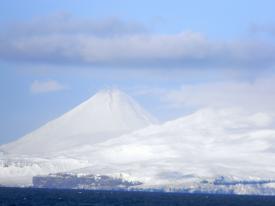
Get these reports emailed to you:
USGS VNS
ALASKA VOLCANO OBSERVATORY WEEKLY UPDATEFriday, February 15, 2013 1:44 PM AKST (Friday, February 15, 2013 22:44 UTC)
CLEVELAND VOLCANO (CAVW #1101-24-)
52°49'20" N 169°56'42" W, Summit Elevation 5676 ft (1730 m)
Current Volcano Alert Level: WATCH
Current Aviation Color Code: ORANGE
Low level eruptive activity at Cleveland continues. Elevated temperatures related to lava in the summit crater were detected in multiple satellite images throughout the week.
The last confirmed explosion at Cleveland occurred in November, 2012. The presence of lava in the summit crater increases the likelihood of additional explosions of blocks and ash with little or no warning. Ash clouds, if produced, could exceed 20,000 feet above sea level. If a large ash-producing event occurs, nearby seismic, infrasound, or volcanic lightning networks should alert AVO staff. However, for some events, a delay of several hours is possible. There is no real-time seismic monitoring network on Mount Cleveland and AVO is unable to track activity in real time.
Cleveland volcano forms the western half of Chuginadak Island, a remote and uninhabited island in the east central Aleutians. It is located about 75 km (45 mi.) west of the community of Nikolski, and 1500 km (940 mi.) southwest of Anchorage. The volcano's most recent significant eruption began in February, 2001 and it produced 3 explosive events that produced ash clouds as high as 12 km (39,000 ft) above sea level. The 2001 eruption also produced a rubbly lava flow and hot avalanche that reached the sea. The most recent minor ash emissions were observed in November 2012.
OTHER ALASKA VOLCANOES
Seismic activity is monitored in real time at 29 volcanoes in Alaska. Satellite images of all Alaskan volcanoes are analyzed daily for evidence of ash plumes and elevated surface temperatures. Some volcanoes may currently display anomalous behavior but are not considered to be at a dangerous level of unrest. Akutan, Aniakchak, Augustine, Dutton, Fisher, Fourpeaked, Gareloi, Great Sitkin, Griggs, Iliamna, Isanotski, Kanaga, Katmai, Mageik, Makushin, Martin, Novarupta, Okmok, Pavlof, Redoubt, Shishaldin, Snowy, Spurr, Tanaga, Trident, Ugashik-Peulik, Ukinrek Maars, Veniaminof, and Westdahl volcanoes are in color code GREEN and volcano alert level Normal. All are at or near normal levels of background seismicity. AVO did not detect ash plumes or significant elevated surface temperatures in the vicinity of any of these volcanoes.
Please see http://www.avo.alaska.edu/color_codes.php for complete definitions of Aviation color codes and Volcano alert levels.
VOLCANO INFORMATION ON THE INTERNET: http://www.avo.alaska.edu
RECORDING ON THE STATUS OF ALASKA'S VOLCANOES (907) 786-7478
CONTACT INFORMATION:
John Power, Scientist-in-Charge, USGS
jpower@usgs.gov (907) 786-7497
Jeff Freymueller, Coordinating Scientist, UAFGI
jeff.freymueller@gi.alaska.edu (907) 378-7556
The Alaska Volcano Observatory is a cooperative program of the U.S. Geological Survey, the University of Alaska Fairbanks Geophysical Institute, and the Alaska Division of Geological and Geophysical Surveys.

